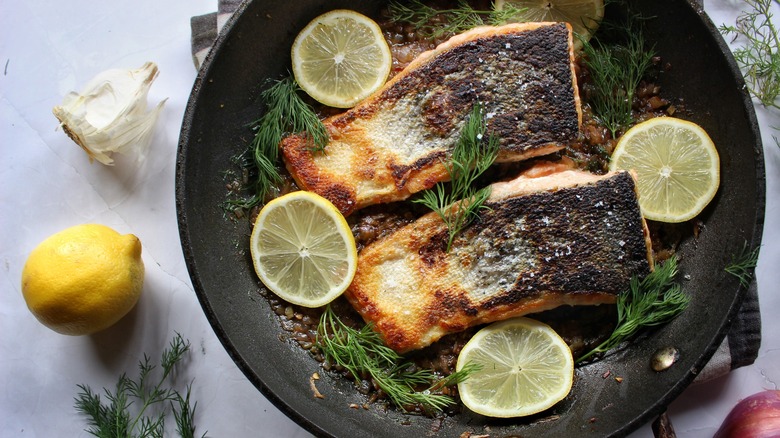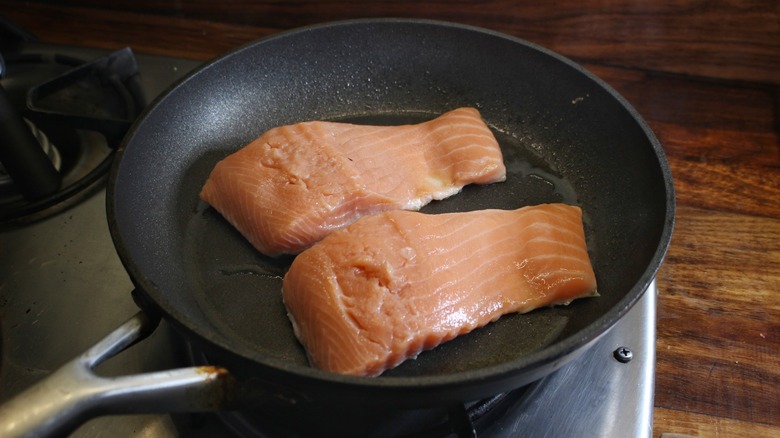Herby Lemon Butter Fish Skillet Recipe
Perfectly portioned for an intimate meal, this herby lemon butter fish skillet is a delightful marriage of meaty salmon, rich butter, zesty lemon, and spicy red pepper. The simple preparation belies the complex flavor, resulting in an impressive meal that wows both the eyes and tastebuds.
The heart of this recipe, developed by A.J. Forget, is the succulent salmon fillets. Choose high-quality, wild-caught salmon for the best results, an ideal center point around which to build a silky pan sauce with a medley of fragrant, zingy flavors. Like many of the best dishes, this recipe celebrates the perfection of simplicity. Two lovely pieces of salmon seared and served in a hot skillet alongside a wonderful sauce and decorated with slices of lemon and fronds of dill. Ready in half an hour, it can serve as both a weeknight staple and the star of a romantic candlelit dinner. Light, delicious, and nuanced, this is definitely a recipe you want in your repertoire.
Gather the herby lemon butter fish skillet ingredients
To cook this recipe, you will need salmon fillets, vegetable oil, butter, shallots, garlic, crushed red pepper, lemon juice, lemon zest, fresh dill, and vegetable broth (or another light broth). Once you have all your ingredients together, you only need to do a bit of chopping and get your skillet searing hot before you're ready to cook.
Step 1: Dry the salmon
Pat the skin side of the salmon with a paper towel to absorb any moisture.
Step 2: Heat the skillet
Bring a medium, heavy-bottomed skillet to high heat and add vegetable oil.
Step 3: Crisp the salmon skin
Place salmon in the pan skin-side down. Sear for 3 minutes.
Step 4: Flip
Flip salmon and cook for another 3 minutes.
Step 5: Remove the salmon from heat
Transfer salmon to a plate, skin-side up.
Step 6: Melt the butter
Reduce heat to medium and add butter to the skillet.
Step 7: Add the alliums
Once melted, add shallots and garlic. Cook for 2 minutes, until the shallots are soft.
Step 8: Spice it up
Add crushed red pepper and cook for 1 more minute.
Step 9: Finish the sauce
Reduce heat to medium-low and stir in the lemon juice, lemon zest, dill, and broth.
Step 10: Finish the salmon
Once broth is bubbling, return the salmon to the pan, skin-side up, and cook for 3 more minutes. Remove skillet from heat.
Step 11: Garnish and eat
Garnish with flaky sea salt, lemon slices, and extra dill, if desired, and serve.
Which other fish can I use besides salmon in this herby lemon butter fish skillet?
Salmon can be difficult to substitute in a recipe because of its unique characteristics. There are several different types of salmon, each with their own unique pros and cons, but all of them are oily fish with firm, pink flesh. If you have been dissatisfied with salmon dishes in the past, our first suggestion is to try a different salmon variety. Much of the cheapest salmon at the grocery store is farm-raised Atlantic salmon, and it is far from the most delicious. A wonderful fillet of wild-caught sockeye or king salmon may be enough to change your tune on salmon entirely.
But if those other salmon varieties are not an option for you, there are some other great fish which that seamlessly replace salmon in this dish (and others). Arctic char is a lesser-known (and often cheaper) freshwater fish from the same family as salmon, with firm, flaky flesh that is often described as a hybrid of salmon and trout. Sablefish, often called black cod or butterfish, is another great alternative, native to the Pacific coast and boasting a firm flesh and high fat content. Just like Arctic char, sablefish is a lesser-known fish with a more stable population, so you can also call it an ecological win for this recipe.
What can I substitute for shallots in this herby lemon butter fish skillet?
Shallots are a wonderful, unique allium, prized for their piquancy and favored for many sauces, but they are not an ingredient that's always easy to find at the grocery store. If your local grocer doesn't carry this particular ingredient, do not worry, there are lots of substitutes for shallots, albeit with slightly different results.
The simplest option is simply to replace shallots with a similar quantity of white or yellow onion. White and yellow onions are slightly more pungent in flavor, so you may wish to reduce the quantity slightly. Shallots also have much thinner layers than onions do, so if you choose to substitute these varieties, be sure to chop them very finely to create a similar final product. Scallions, green onions, and spring onions (names that are often used interchangeably) have a more delicate flavor and also make good replacements for shallots.
Herby Lemon Butter Fish Skillet Recipe
This recipe is proof that simple dishes can have the most impact. Use salmon, sablefish, or char in this quick, easy skillet with a lemony, buttery pan sauce.

Ingredients
- 2 (6-ounce) salmon fillets
- 1 teaspoon vegetable oil
- 4 tablespoons butter
- ¾ cup finely diced shallot
- 1 tablespoon minced garlic
- ¼ teaspoon crushed red pepper
- 1 tablespoon lemon juice
- ½ teaspoon lemon zest
- 1 tablespoon chopped fresh dill, plus more for serving
- ¼ cup vegetable broth
Optional Ingredients
- Flaky sea salt, for serving
- Lemon slices, for serving
Directions
- Pat the skin side of the salmon with a paper towel to absorb any moisture.
- Bring a medium, heavy-bottomed skillet to high heat and add vegetable oil.
- Place salmon in the pan skin-side down. Sear for 3 minutes.
- Flip salmon and cook for another 3 minutes.
- Transfer salmon to a plate, skin-side up.
- Reduce heat to medium and add butter to the skillet.
- Once melted, add shallots and garlic. Cook for 2 minutes, until the shallots are soft.
- Add crushed red pepper and cook for 1 more minute.
- Reduce heat to medium-low and stir in the lemon juice, lemon zest, dill, and broth.
- Once broth is bubbling, return the salmon to the pan, skin-side up, and cook for 3 more minutes. Remove skillet from heat.
- Garnish with flaky sea salt, lemon slices, and extra dill, if desired, and serve.
Nutrition
| Calories per Serving | 631 |
| Total Fat | 48.3 g |
| Saturated Fat | 19.7 g |
| Trans Fat | 0.0 g |
| Cholesterol | 154.6 mg |
| Total Carbohydrates | 12.3 g |
| Dietary Fiber | 2.2 g |
| Total Sugars | 5.0 g |
| Sodium | 116.2 mg |
| Protein | 36.8 g |















